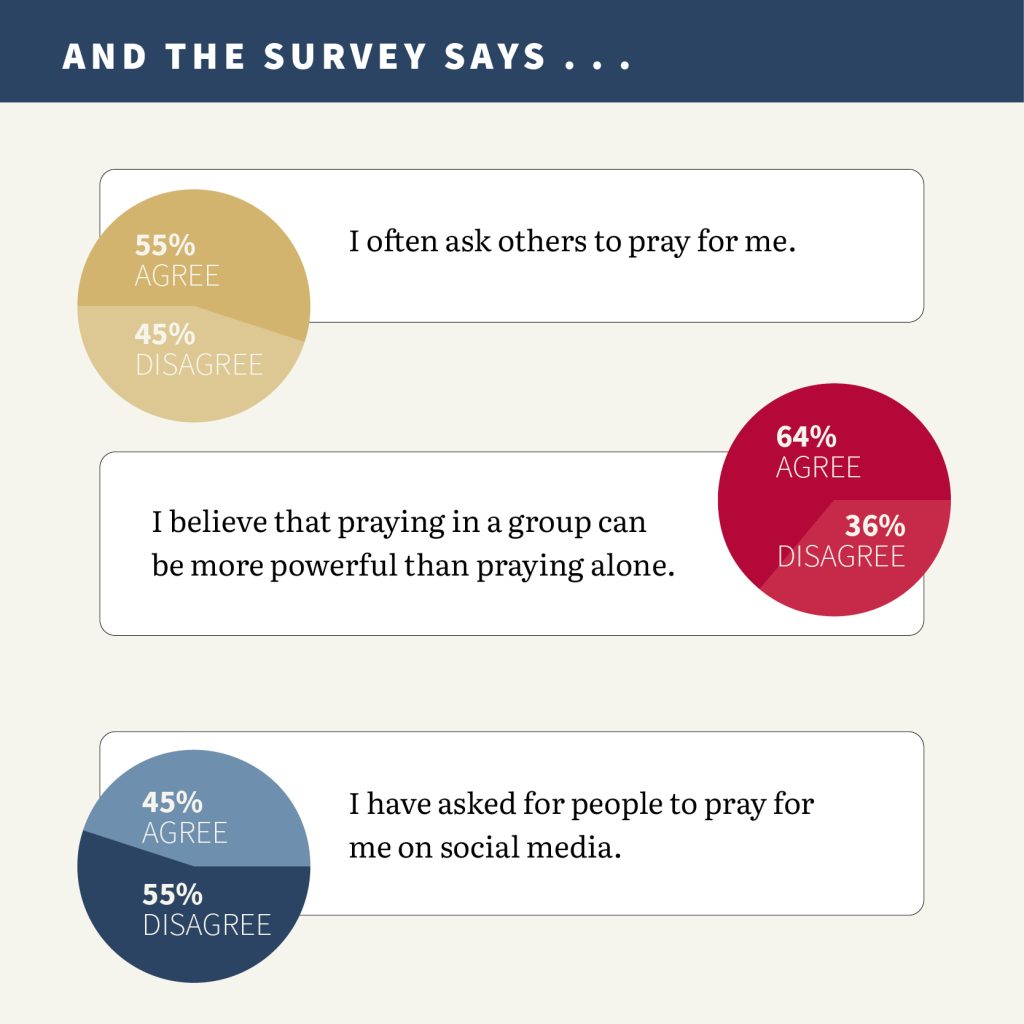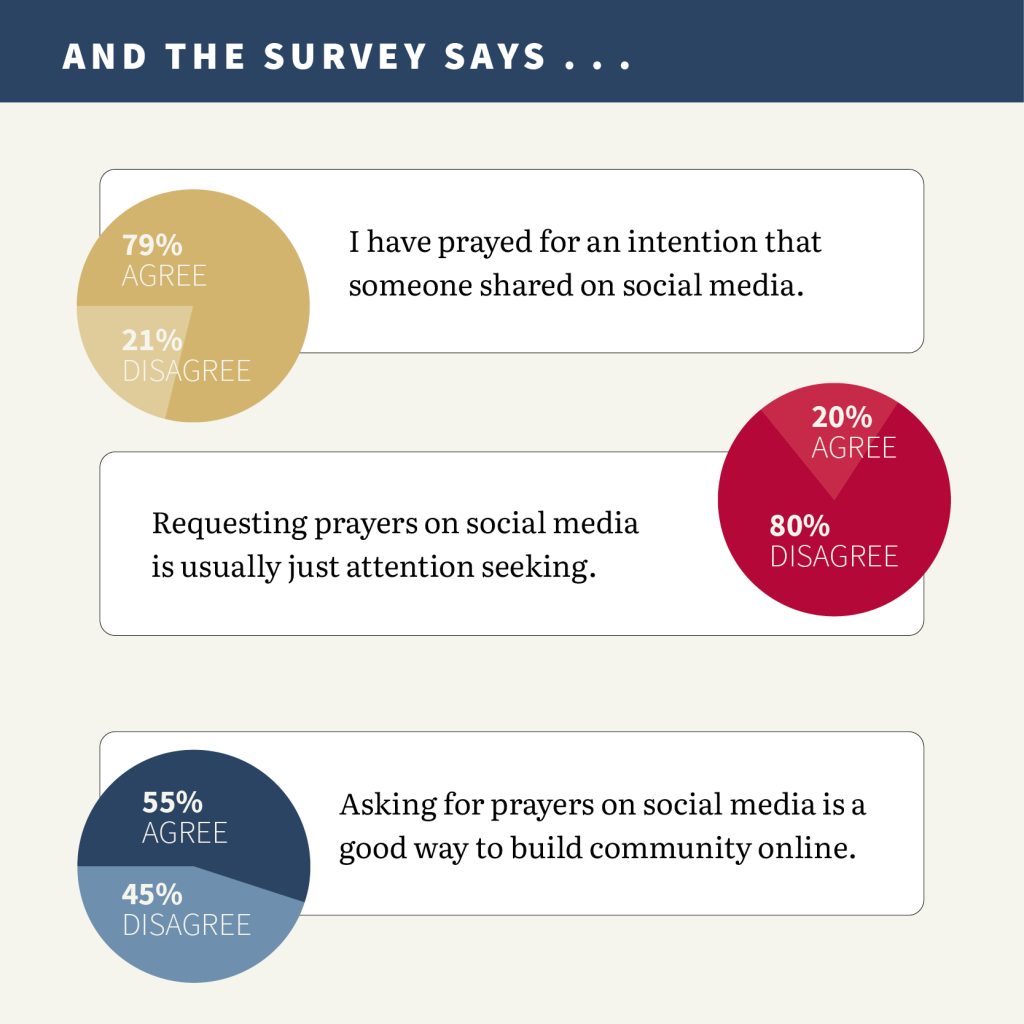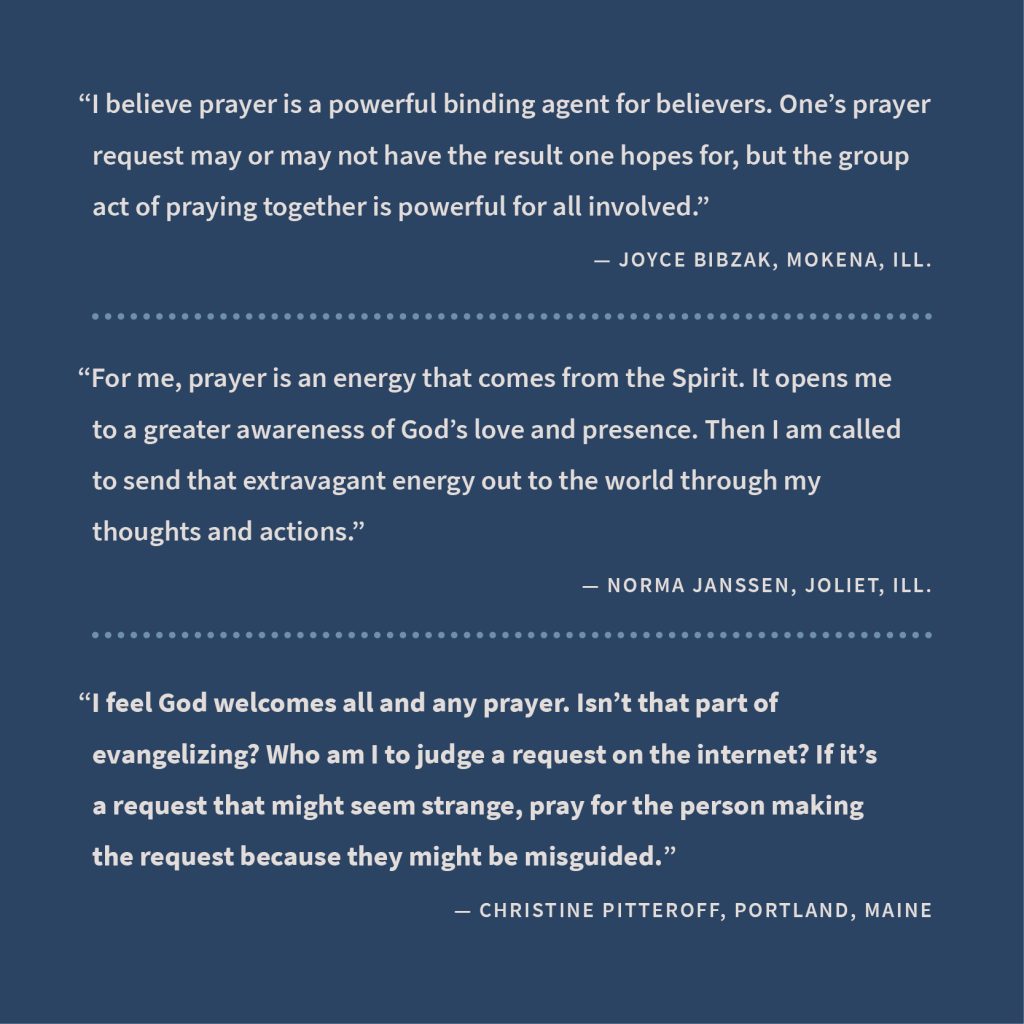If a tree falls in a forest and there is no one around to hear it, does it still make noise? If a person lifts their praises and petitions to God without asking their social media following—or Bible study, friend group, or members of their extended family email listserv—to join them in prayer, does the Divine still listen?
The answer, ostensibly, is yes. Jesus himself, when addressing the crowd gathered at his Sermon on the Mount, gives specific instructions about the ways in which one should pray, and these ways don’t include involving others.

“Whenever you pray,” Jesus says, “do not be like the hypocrites, for they love to stand and pray in the synagogues and at the street corners, so that they may be seen by others. Truly I tell you, they have received their reward. But whenever you pray, go into your room and shut the door and pray to your Father who is in secret, and your Father who sees in secret will reward you” (Matt. 6:5–6).
Despite Jesus’ clear instructions, many people these days go public with their prayer.
Take, for instance, my monthly Bible study. We meet the third Tuesday of every month, and as a group of mostly young(ish) moms, we begin our gathering at 8 p.m. after toddlers have been tucked into bed. The study portion of our evening concludes by 9 p.m., yet there are months when we remain cozied up on the couches—or trapped, depending on your view of the situation—until we’re pushing the 11 o’clock hour. That gap in time is filled with prayer requests.
I’ll be the first person to admit that I tend to find hearing the hopes and concerns of this loose friend group more interesting than the preceding video and discussion about whichever Pauline epistle our leader has chosen. To me, Prayer Request Time is an invitation to vulnerability, honesty, and openness, and I value the opportunity that it presents for deeper knowing and understanding within our small group.
And yet when one of my friends, a fellow Bible study member, expressed frustration to me about the two-hour-prayer-request-marathon, I could see her point. In her words, “This isn’t group therapy.” Besides the infringement on all of our much-needed sleep, there is something slightly annoying about the way in which a few individuals take this time as a chance not only to ask for prayer over their particular struggle but to rehash, process, and cry about that struggle.
My Bible study is one place where I witness an abundance of prayer requests; social media is another. These requests run the gamut of asking for prayers for a loved one’s upcoming surgery to prayers for smooth travels with no flight delays, prayers for their child’s behavior at school, or prayers for that same child’s performance at their Little League game. No prayer request is too small or too big for social media, it seems.
Asking for prayer is a common practice, but I can’t imagine that many of us believe God waits to wave a magic miracle wand until a quorum of prayers for a particular end have been received. Similarly, I think that most of us would agree that God listens as closely to the secret, silent desires of our hearts as God does to the prayers expressed loudly and publicly.
If my speculations are on point, then we are left with the question: What is the purpose of requesting prayer? So many people do it. If not to ensure otherwise elusive divine intervention, what, in the end, does asking our friends, family members, and social media followings to join us in prayer accomplish?
For starters, making a prayer request gives us the opportunity to consider that which we desire. One of the best pieces of advice I was given in my job-searching days was to practice answering potential interview questions out loud. “You might think you know how you would respond to a statement or quandary, but actually speaking the reply to potential questions will help you to formulate more specific answers,” my advice-giver told me.
The moment I first gave her suggestion a try, I realized that she was right. I initially stumbled over articulating out loud what had felt so clear and straightforward in my head, but with enough verbal practice, my thoughts and eventual words became succinct and coherent.

The same logic applies to prayer requests. We may think we know what we need and want but distilling our desires into a few sentences—or 280 characters, if your request is a tweet—facilitates clarity of mind.
Unlike an interview, where coherence is for the sake of the person questioning and listening to us, clarity in prayer benefits us more than it does God. God, after all, knows our yearnings long before we speak them. We don’t, necessarily, though. Naming our desires can help us reflect on our wants, our actions, our relationships, and more.
For instance, I recently found myself requesting prayer for a friend who is struggling with infertility. She had been on my mind lately but in a vague, ambiguous sort of way. In my moment of requesting prayer for her, I realized the extent to which her troubles weighed on me, and I was prompted to reach out to check in and extend some loving care.
This shows that one purpose of asking others for prayers can be that requests may translate into action. Another may be that it builds community and deepens relationships. If naming our desires benefits us because it helps us know what we need and want, it also helps our relationships because it enables the people with whom we are entrusting our cares to know us more intimately. In deeper knowing, there is deeper connection.
Connection has value on a purely relational level. Knowing what matters to the people in our lives, knowing what they worry about, knowing what brings them joy, knowing what they are grateful for—this kind of awareness makes the world a softer, warmer, more hospitable place.
It also has practical, tangible value. For instance, someone makes a prayer request on social media for their son, recently diagnosed with autism, and all of a sudden, they have old acquaintances from high school, distant friends, and an ex-boyfriend’s cousin’s wife reaching out and sharing their stories of hope, ideas for resources, and validation. These offerings can be a lifeline, an answered prayer, so to speak.
In my eight years of working as a director of faith formation at a parish, where I taught sacramental preparation classes, religious education for a spectrum of ages, and adult workshops, I reinforced over and over again that there is no wrong way to pray. Indeed, one of my favorite aspects of the Catholic Church is the abundance and variety of prayer forms and styles developed over centuries and passed down through both tradition and modern avenues.
From the rosary to Ignatian imaginative prayer to Gregorian chant, there really is something for everyone. Pray extemporaneously, pray through song, pray utilizing an app or podcast, pray with the words recited by millions of Christians over the millennia: Any actions we take or words we utter are effective if they aim at union with the God within us and around us, as well as with our fellow humans on the spiritual journey.
Whatever form of prayer appeals to us most, we need to remember: Prayer doesn’t exist for God, who—ever ancient, ever new—goes on being God with or without our praise and petitions. Prayer exists for us humans, trying in our humble, desperate, hopeful ways to connect with God and our human family.
As I see it, requesting prayers and responding to others’ requests is just one more way of reaching toward God, on behalf of and with others, and toward one another.

Results are based on survey responses from 58 uscatholic.org visitors.
This article also appears in the October 2023 issue of U.S. Catholic (Vol. 88, No. 10, pages 31-35). Click here to subscribe to the magazine.
Image: Unsplash/Chris Liverani













Add comment